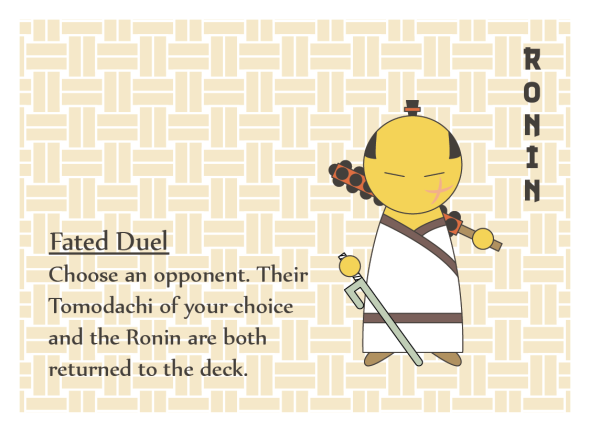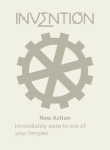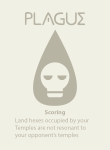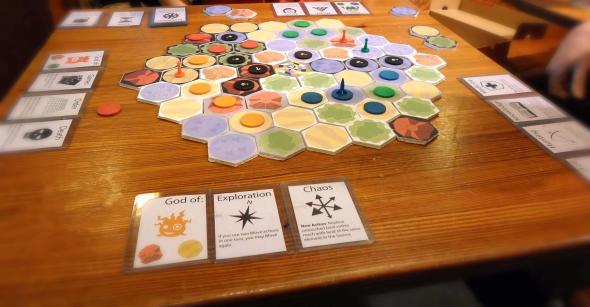Slight delays and… pattern plays? Whatever.
Posted: November 19, 2013 Filed under: Updates | Tags: NaGaReDeMon, Process, Shima 1 CommentOh god rhymes. They seem like a such a good idea when you start, but then you make some dumb-ass choice for the end of your first phrase and everything falls apart. Tonight I’m really posting for momentum purposes, not because I have a lot to say. November has been busier than I thought it would be (read: Pokemon has been getting really good), so I really have nothing to show right now except for these patterns. 
Some of these patterns already existed, so let’s go through them left to right, top to bottom (think phone buttons).
1: Water – Obviously already used
2: Brown Squares – For my money, too elaborate, but still traditional and possibly good for something.
3: Tatami – New texture that I am using for the Tomodachi. Not actually a traditional texture, so to speak, but it looks nice on the card.
4: Rice Paddy – A great pattern that I really need to redraw, but one that is already used to great effect on the board.
5: Orange Overlapping Circles – Way too harsh for my taste, but it could have some use if we chose a better color for it.
6: Black Hexagons – A really interesting new pattern that I came across and roughly recreated. Could be good as a brown for a new storehouse or harbor texture.
7: Wood Grain – Already used as boats, but if things get shuffled around this could become any of the three “wooden” texture we’ll need.
8: Tan Stars – One of my favorites, and already used in the pasture. I need to redraw it, but otherwise it’s great.
9: Purple Tortoise – A very traditional texture, one that we used for Tomodachi before, but something that I would love to re-purpose because like I said, it’s super traditional.
Right, so there’s that. As I was typing this I did realize I have one more thing to post.
This is some terrible, horrible graphic design, but hey, it’s a work in progress. Later in the week I’ll have a pow-wow with Alex and Morgan and hopefully we (read: Morgan) will find a good way to array the art and information. For now, enjoy the lovely tatami texture, and try not to be frustrated because I CLEARLY FORGOT TO RECOLOR THE HAIR TIE AFTER I CHANGED THE KIMONO TRIM TO PURPLE. FUCK.
The Shima play-test: success?
Posted: November 11, 2013 Filed under: Updates | Tags: NaGaReDeMon, Playtest, Process, Shima, Update Leave a commentSo finally I’m getting around to posting these pictures. This is a mid-game picture from our recent play-test of Shima. It contains a good deal of new elements, so let’s work through them one at a time.
The first new thing, and probably the most obvious in this picture, is the little personal islands/circle things. After playing many cramped games of Shima on the shared board, it became clear that A) the shared board gains us nothing and B) there are real advantages to having separate islands, including a simpler scaling from 2 to 4 players. So I bought a pack of index cards and a box of crayons (top left), and we made some little islands. Here’s Ian’s island and storehouse (to be explained) since he had the most artistic approach.
For reasons I can’t explain, he drew his fields in this order (rice paddy, pasture, ocean), then proceeded to set up his storehouse on the ocean end. The intended order is storehouse-pasture-paddy-ocean, but hey, he spent the time drawing nice colorful lines, so I’m not going to argue with him. As you can see, he has workers in his fields and 2 cows in his pasture, neither of which are kobe (which would be denoted by red circles beneath them). He also has 2 fish in his storehouse, and a barrel of sake in-progress. Like I said before, the storehouse is a new concept, and one which we’re using to sort out a few different problems. The first is fish storage. The rule of “half your fish expire” was wonky and constantly caused problems and miscalculations, so now there are just X barrels (12 in this game, but probably 8 or 9 in the final design). We are also using the barrel system to produce sake: players pay three rice to place one rice token in a barrel, and a season later a red honor token is placed beneath it, and it becomes sake. We are also considering a system that allows sake to sit for months on end and accrue honor, but that’s still up for debate.
The other big new feature is the central “harbor.” In this playtest, we each chose a color (Purple/Blue/Yellow) and used the colored winks to place workers at docks on the central board. In this picture, I have a purple wink at the eastern and south-western dock, Ian has yellow winks at the same docks, and Morgan has blue winks at the north-western and eastern harbors. We’re still working out the precise mechanism of the harbor, but it worked very, very well in this primordial state. Morgan’s Diplomat card was just as valuable as in the older version of the game, but it wasn’t as over-powered. Speaking of boat mechanics…
These are the newest version of the boat cards. I’ve moved some things around from last time I posted, and I’ve made an… unusual modification to the rules text. If you couldn’t tell already, they’re haiku. I desperately wish I could do all the rules text in haiku, but the truth is I chose these two to preview because these are the only two I could reduce to haiku form. This may be a task that spend some time on later, because come on, how awesome would it be to have all the tomodachi and boat text written as haiku? Either way, I’ve removed the unsightly harbor texture from the previous version, and I’ve added in the lightened bar that’s present in other printed game elements. The only thing I’m unsure of is how best to represent the prices, and even more specifically how to help the Rice token stand out from the background. The dark lines here aren’t my favorite.
So that’s that. I’ll be finishing up the boats this week, and moving on to some more intensive Tomodachi design soon. We may have an opportunity to play, or at least experiment, on Saturday when Alex and I (along with many others) will be waiting in line at 5 in the morning to get tickets to Ian McKellen and Patrick Stewart’s Broadway show, Waiting for Godot. Until then…
Final cards and preliminary boards
Posted: April 21, 2013 Filed under: Updates | Tags: Manic Mechanics, Process Leave a commentI will be typing very little here, and posting a lot of images. Also, creating these little galleries is a huge pain for some reason. Anyway, here are 4 of the final 25 cards in the new Manic Mechanics.
Feels good to have something from this project totally finished. After a good amount of graphic design, and a handful of rule and ability changes, the vehicles are complete. With that done, I turn my attention to the zone cards.
In my past few posts, I showed some diagrams of the new boards. As of now, the paths are created, but the cards are undecorated. I’ve hit a snag in that department actually. The visual appearance was a major criticism of the original zones, but now that the boards are smaller, I can’t figure out how to fix it. For now, enjoy the simplistic versions. Oh, and these are only 6 of the 24 zones (12 double-sided cards). Later I will do some fun math to determine the amount of racetracks that can be created.
Next post: A Satellite Salvo update, and hopefully some nearly finalized zone art. Actually, all that’s left to do with this game is re-write the rules and prepare the new box. The finished product isn’t really that far off! Hooray!
Rethink of the rethink, and more getting ahead of myself
Posted: April 10, 2013 Filed under: Updates | Tags: Manic Mechanics, Playtest, Process, Shima Leave a commentThis will be pretty brief. The first bit is about Manic Mechanics. Last week I posted a diagram of the new Zone mats, and this week I’m posting another new diagram of even newer Zone mats. I think this design will be better and more flexible, not to mention easier to create.

So now the cards will be more universal. Instead of straightaways and turns, there are just diagonal lines that connect at the corners. What’s more, these cards allow for some interesting, smaller races. Lastly, this orientation creates space for about 7 spots per card, which makes the full 12-card race a very similar length to the original game.
The second thing I worked on this week was the update to Shima. Unfortunately, I’m really not supposed to be doing that. I told myself that I would work on the games two at a time, finishing both before I moved on. But I had a cool idea, and I wasn’t going to just let it go by. Instead, I did a really brief proof-of-concept for a stand-alone Sumo game. If you recall, when Alex and I published Shima, we created separate minigames to differentiate our versions. I added a Sumo game to my version, but it didn’t quite work. This new thing, on the other hand, does work.
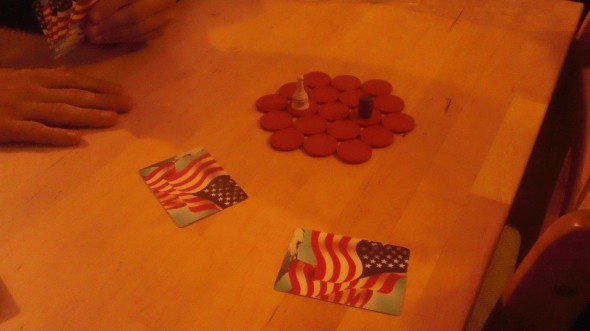
Again, this prototype is made of a deck of cards and bits from Rum Run. In this new(ish) game, opponents play cards simultaneously to manipulate the pawns in the small, hex-grid Sumo ring. On the first turn, the players stand apart.
Then the cards are revealed, and the stronger player moves into the center. After that, the players push and pull each other around the board until one is pushed outside of the ring. There isn’t much more to say at this point, but I’m not really in the business of taking pictures and not posting them.
Anyway, I will eventually start to make real progress on Manic Mechanics, and hopefully post frequency will increase. Until then, once a week seems like a good schedule. Stay tuned.
Deep sadness
Posted: April 3, 2013 Filed under: Updates | Tags: Alex Coulombe, Competition, Manic Mechanics, Process, Satellite Salvo, Terra Neo, The Game Crafter Leave a commentWe didn’t win. Super sad. The winning game looks awesome though, so I guess slightly less sad. I’m not going to say any more about Terra Neo until it’s published (soon, hopefully).
Here’s what’s been happening in the meantime. Manic Mechanics is plodding along slowly, but I’ve started to work on something I didn’t expect to do: totally new board design. I don’t mean graphic design, I mean actual design. Here are some diagrams about that.

This shows possible track layouts for 12-card boards. The cards themselves would be the Game Crafter’s Jumbo Cards, which measure 3.5′ x 5.5′. I’m going to be cutting some out of paper to test out the sizing pretty soon. Might even do a playtest. Haven’t decided. Either way, this would change a lot in the game, including actual gameplay elements, since many cards reference their “zone.” If the zones get smaller and more numerous, certain vehicles will be gain power while others will lose power. It’s something I have to look at. But the ultimate goal here is to get this game to fit in a smaller box, which will be possible if I use these boards.
Meanwhile, back at Satellite Salvo, a new print-and-play has arrived. I still need to make some tweaks to it, but otherwise it’s pretty much finished.
 The tricky bit here is the folding. By folding the sheet along the two horizontal lines, you get a very cool print-and-play object. The two upper sections stand up like a tent to shield the lower section, which of course is the secret information. All of the rules fit in the middle, so they can be referenced at any time, and the whole thing can fold flat, leaving only the top panel with the Enemy Planet and Arsenal visible. All you need are 5 dice and a pencil.
The tricky bit here is the folding. By folding the sheet along the two horizontal lines, you get a very cool print-and-play object. The two upper sections stand up like a tent to shield the lower section, which of course is the secret information. All of the rules fit in the middle, so they can be referenced at any time, and the whole thing can fold flat, leaving only the top panel with the Enemy Planet and Arsenal visible. All you need are 5 dice and a pencil.
Well that’s it for now. Not sure what the schedule is in the next week, but my hope is to find some time to get serious about Manic Mechanics. It’s sort of the big project right now, and if I could knock it out I could move on to some other games that are frankly more interesting to me right now. Until then.
Reluctant Pirate Games 2.0
Posted: March 5, 2013 Filed under: Updates | Tags: Competition, Manic Mechanics, Process, Satellite Salvo, Terra Neo, The Game Crafter 1 CommentBefore I begin this post in earnest, I’m going to quickly point out that the Game Crafter has published the list of Map Builder Design Challenge entries, and it is extensive and intimidating. You can check them out here.
So, Reluctant Pirate Games 2.0. An ambitious title befitting an ambitious time. Let me start with a sad, sad picture.
When the Game Crafter updated their website, all old games had to be updated or else they would be un-published. Because at the time I was not updating my website or really doing much of anything, I just let it happen. When I finally went back to the site to check it out, this sad state of affairs greeted me. That “Need help?” button suddenly seemed like it was mocking me. Not only had my successful games become unpublished, but I realized how many games I recently made that never actually got finished. What’s more, it reminded me that all of the my old games could use revisiting. With that in mind, I am launching this campaign. By the end (whenever that is) I will have updated or completed every game on this list. To keep it interesting, I’m going to tackle them in pairs. The first pairing is, fittingly, Manic Mechanics and Satellite Salvo. My first two games, possibly my best, and two incredibly lame alliterations. Can’t wait.
Although I’ve done some text-based work on Satellite Salvo in the past few days, most of my time since Terra Neo ended has been spent going over Manic Mechanics. Tonight I actually sent out a survey to all of my collaborators to ask them what they thought of the potential changes. Let me lay these changes out for you.
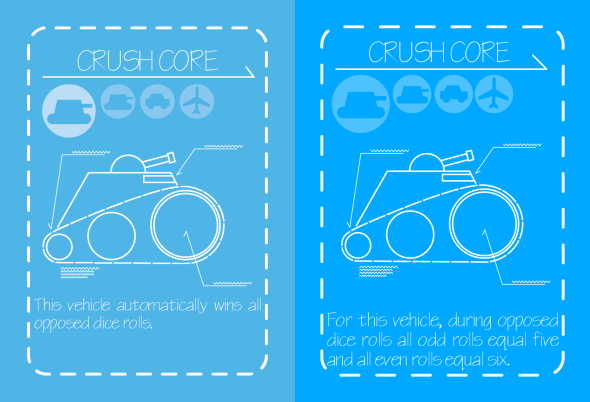
First, I want to tweak the card layout and appearance. Like an idiot I put the old card on the right, because I hate intuitive graphics. But either way, you can see the differences are small. Still, any change could be trouble, so I thought I would ask. This card also has a slight change in effect, but that’s not really part of the survey.

I’m also thinking about punching up the artwork with a scribble effect. I’ve made some cards that integrate this fill into the vehicles, but I’m even less optimistic about that idea. Either way, it’s a really simple Illustrator command that produces this, so I’m not worried about big changes meaning big piles of work.

Also, I’m totally changing one of the vehicles (Scorpedo used to be called Warpedo, and it did something totally different) and possibly adding a bizarre wild-card vehicle. It’s called Multiball. Get it? Like “multiple,” but referring to the roundness? I’ll see myself out…
The last two things I have to do are without a doubt the most difficult. One is to fix the boards, which is something I have tried to do repeatedly over the past few years. Every time I try to edit them, I realize that I am as stumped as I was the day I first drew them. The other big problem is the rules. Between these two things I may have actually won the first Game Crafter contest. But I didn’t because the board was ugly and the rules were incomprehensible. So that’s going to be an adventure, especially since I have decided to use this project to teach myself InDesign. Hooray…
What this means for my website is that I will finally have stuff to post again. I will be working on these two games continuously over the next few weeks, with my tentative deadline being Easter. That way I can celebrate by eating donuts again after the horror of a gluten-free Lent. If my posts get increasingly angry until then, that’s why. Let’s hope not.
Terra Neo: Great game or greatest game?
Posted: March 1, 2013 Filed under: Uncategorized | Tags: Alex Coulombe, Competition, Process, Terra Neo, Update Leave a commentI’m typing this at about 10 the night that Terra Neo is due. Alex and I are doing final touches and going over the shop page in preparation for the submission. But, while I have a few minutes, I figured I’d starting writing up the second development post for this game. Last time we left our heroes as they exited Prototype Forest and headed towards the Fortress of Final Graphics.
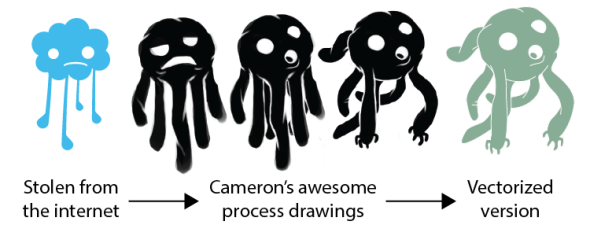
Yeah, the cloud guy got even more awesome, if that’s even possible. This is why I always outsource the creation of soft things. Some people really have the touch, and I am not one of those people. Either way, there are 3 more, equally cool gods in the game, but I can’t show everything now, can I? Next up was the color scheme. As always, we turned to our friend Morgan, whose graphic skills have transformed our games in the past. Let’s see what he did with this one.

And it’s not just that these colors are better. There’s a unity that comes from his approach. For instance, I just chose colors that I needed and I thought looked ok. Morgan reference sanskrit cave paintings to find earthtones and natural pigments that were geographically similar. Let that sink in. While you do, take a look at the thing that I actually did without anyone’s (direct) help.

Unfortunately, there was just too much between the prototype art that the final art to actually go into it. Needless to say, shit got real. The resonance went from awkward outer coloring to an overlaid pattern of circles in 3 different scales. The land types below that became highly graphic representations of geography instead of bad drawings. All in all, really fun stuff. The last thing we did was update the upgrades. I don’t really have a good picture of this process, since it was mostly just a color shift, so instead here’s a few of the cards in a little gallery.
Anyway, I really shouldn’t be writing this when we’re right up against the deadline. But I wanted to officially put this whole process up, and here it is. I will hold off on an official “Publish” announcement until Alex and I have it in our hands, so any more news will have to wait until then. In the meantime, I’m going to take the weekend off from this kind of stuff, and early next week I will start detailing the upcoming rebirth of Reluctant Pirate Games. Hooray!
Well that’s quite enough of that…
Posted: February 27, 2013 Filed under: Updates | Tags: Alex Coulombe, Competition, Playtest, Process, Terra Neo, The Game Crafter Leave a commentSo many things. Not really sure where to start. So I’ll just begin with what’s happening right now, drop back into the recent past, then look forward into the next few months. Alright, let’s do this.
Alex Coulombe and I are 95% finished with a new contest game. Since I wasn’t really posting when this contest was announced, I’ll post it now. It’s called the Map Builder Design Challenge, obviously from the Game Crafter. It’s a pretty simple premise: design a game with a dynamic map, either created at the outset of the game (Catan style) or during the game (Carcassone). I hadn’t really produced a solid game in a while, so I decided to ask Alex if he wanted to do another collaboration, since the last one got us into the finals. If I had been posting at the time, I would have laid out the competing ideas we had, and how they evolved, but instead, here’s a picture of us playing a rough version of what would become the final game.
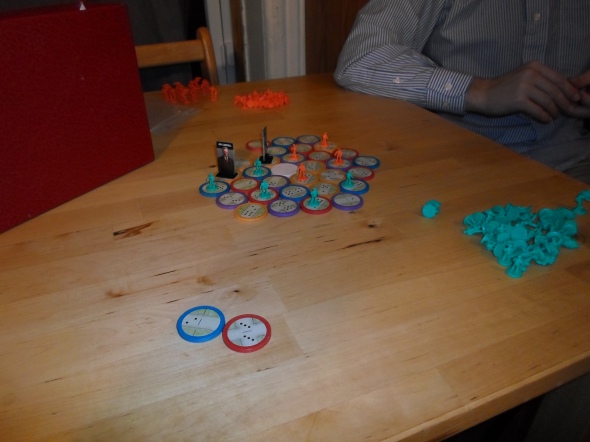
A couple things to note here. 1 is that we are clearly using pieces from Alex’s award-winning game The Rum Run and pieces from the very cool Risk: Metal Gear Solid Edition. 2 is that I am dressed up. Not sure how that’s relevant, but it’s so rare for me that I thought I would mention it. Also, at this point, the game was tentatively being called “Super Little Demi-God.” Luckily, the title changed later. Anyway, I’ll try and explain the basics of the game based on this picture.
Super Little Demi-God was, and I guess still is, a hex-based map-building game. Without going too far into the story, you play as a Demi-God who, along with their siblings, is building a brand new world separate from the world of their godly father. Imagine Hercules and his brothers and sisters seceded from Olympus to make a new world, except instead of the demi-gods being heroic and just, they’re petty and obnoxious. Regardless, the game begins with no world existing, just a center tile (the white token for those following along on the picture). Depending on the number of players (in this case 2), the world has a limited “radius.” You can see that in this instance the world has a radius of 3. This is important because the main action of the game is to place hexagonal land tiles and fill out the world to its maximum size. Unlike other map-building games, though, you are not an all-powerful being who can do whatever they want. You are limited to placing land on spots adjacent to your characters, which in this play-test are two of the characters from MGS Risk. This creates an interesting early world, where each player attempts to build out a little private area, bumping elbows as the areas expand. The little blue and orange dudes in the photo are Temples, which you can also build. These are how you actually win the game. At the time of this play-test, the scoring rules were not fully formed, but basically the more temples you had the better.
So that’s where we were about a month ago. The game was pretty simple. Then things took a turn for the awesome. Here’s a great picture of a public play-test we did at a board-game Meetup in Tribeca.
Pretty cool, right? At this point, the title of the game had changed to “New Pantheon.” I mocked up some land tiles, and we added upgrades. Also, that last sentence was way to casual for such a big leap. Either way, the game surged forward in both sophistication and strategy. The people who played it really seemed to like it too. As you can see, the basic structure is the same. There are land tiles of various types, some player pawns, and their corresponding temples. What’s more apparent in the picture is the concept of “Resonance.” If you look at the closest row of hexes, you will see that there are central land graphics surrounded by an outer color. For instance, there’s a red mountain on the right with a black background, and a yellow desert in the middle with a white background. The four land types (mountain, desert, forest, ocean) each break into three different “resonances” (black, white, grey), both of which affect gameplay and scoring. Now, look at the nearest “character” card (the one with the crazy dude on it). It has two land symbols on it, which correspond to that player’s “native land.” This concept is important, because you can only build temples on that kind of land. The resonance, on the other hand, is how temples are scored. But honestly, this isn’t really worth explaining here. There will be some fantastic pictures tomorrow which will do a much better job of explaining it.

Lastly, and this deserves its own paragraph, is the upgrade system. See the black tokens on the board? Those are placed on a land tile when it has been “siphoned” of all of its magical energies, making it useless for scoring or temple-building. Every time you do that to a piece of land, you can take an upgrade from the pile. In this game, the blue demi-god chose to become the god of Hunting, Knowledge, and Chaos. This granted him powers beyond the standard actions in the game. This was probably the biggest leap for the game at this stage, as it went from a repetitive, hardly escalating game to a snowballing adventure of increasing power and madness. Plus, you know, more art is always better. More on that later. Oh, and take a look at the character card above. I stole the god drawings from the internet, so they couldn’t be used in the final game. But I seriously loved that cloud so much that when I commissioned the final art I specifically said that something like that had to be in there. And oh boy was that a good idea. And because I’ve tagged the post anyway, I’ll say that after these play-tests, the name was changed one last time to “Terra Neo.”
So, to the future. Tomorrow I will post the rest of the development of this game. This includes final art, and some tweaks to how the game functioned. It’s due on Friday night, but all that’s left to do is for Alex to finish the rules, so unlike with my last two games, I am hardly worried. Once that is done, this website and I will embark on a long journey to restore my productivity and publication to acceptable levels. But, for the last time, more on that later. Stay tuned.
Back on track (hopefully)
Posted: October 30, 2012 Filed under: Updates | Tags: Competition, Founding Fighters, Process, Update Leave a commentThis is the first post in over a month. In that time I have acquired a new computer, moved to New York, and survived Hurricane Sandy. Things have been frenzied. The good news is I am settled and prepared to work on this stuff again. The bad news is this game is due in two weeks. Damn. I’m still not ready to post the dragon AI information, but within the week I will be running a play-test of the game, and that should generate a pretty interesting post. Until then, enjoy this great picture of George Washington.

If con is opposite of pro, then is Congress the opposite of progress?
Posted: October 1, 2012 Filed under: Updates | Tags: Founding Fighters, Process, Update 3 CommentsToday’s terrible one-liner brought to you by the Continental Congress, which is exactly what you will be saving in my upcoming game The Founding Fighters. I’ve been hard at work at the gameplay, but the graphics work has been slow. That is, until tonight. So here’s some images and some explanations that are long overdue.

So besides the Dragon board, which I’ve posted before, your adventure will also take place on a map of early America. Starting at the Canadian border, a pawn representing the dragon will work its way down the board until it reaches Philadelphia. I don’t think I need to point out where that is. As you go down, you may enter fields (yellow circles), towns (grey circles), and cities (black squares). The path you choose is, um, a work in progress. More on that in another post I promise. Anyway, when the dragon takes its “turn,” it will roll for its thrashing attack, then determine its movement. While in a city or town, thrashing will not only throw you off, but will also cause “casualties.” This is a mechanic I’m introducing as a secondary defeat condition, although not an alternate win condition. The reason you might want to go into a city is that while there, the dragon may not move to the next space on the map, giving you more time to attack. The trade-off is that in the city they can potentially kill citizens. Again, a Dragon AI post will have more information about this stuff.

My god do I love those drawings. I don’t think I would even be considering doing this game without them. Obviously I’ve vectorized them, but basically I just followed what the artist drew. Anyway, here’s a shoddy character card that I’m posting to illustrate the basic workings of a Founding Fighter. First, there are the stats. During a single turn, a player must allocate 4 units of “effort” into three different actions. The first is movement, and the number of spaces that can be moved is determined by the character. For Franklin, using 3 effort to move allows him to run 5 spaces, while only using 1 lets him move 2. Effort can also be spent on attacks or special abilities, like the ones written on the card. Each character will have two abilities, with one costing a single effort unit and the other costing 2. Finally, whatever is left over will be used to “hold on” during the thrashing of the dragon. Benjamin Franklin is a very slow character, although you just have to take my word for it in the absence of comparison characters, but he is very good at holding on. Thrashing is a modified 2d6 roll, so you can imagine that having 11 hold strength means he can grab hold and stay on through some bad stuff. In terms of special abilities, I wanted Franklin to be a support character, who plods along creating improved circumstances for his teammates. Also, I’m not opposed to the idea that he could be used to slowly crawl up the neck and attack the head using his extreme hold strength. Either way, should be fun.
The other reason for this post, and I guess the title, is that I can’t be sure how consistent my progress on this game will be in the coming weeks. I’m actually planning to move within the month, and that will take precedence over game design. Obviously I will continue to dedicate brain time to the project, but actual work is less guaranteed. I do hope I can bring this game to completion, since I am increasingly excited with it, but I just have to put it out there now that it’s not my first priority right now.

